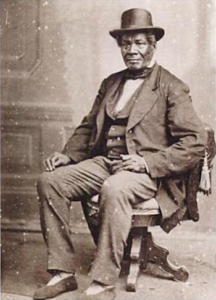
George Bonga
On this date, we celebrate the birth of George Bonga in 1802. He was a Black Ojibwe fur trader and trapper.
Born near Duluth, Minnesota, he was one of two sons of a Black father and an Ojibwe mother. His father, Pierre, was the son of Jean and Marie-Jeannette Bonga, slaves. They were brought to the fort on Mackinac Island, Michigan, by their master, Captain Daniel Robertson. He was a white-British officer who commanded the fort from 1782 to his death in 1787. The couple was freed at his death and legally married. Bonga and his wife opened the first hotel on the island.
Pierre Bonga worked as a fur trader with the Ojibwe near Duluth. His first son, Stephen Bonga, born in 1799, also became a fur trader and translator in the region. The sons had a sister, Marguerite, born in 1797. Pierre Bonga was a relatively successful trader, so he sent George to school in Montreal.
Bonga then worked for the American Fur Company as an independent fur trader. He held ports in Ottertail, Lac Platte, and Leech Lake, MN. He could speak English, French, and Ojibwe and, in 1820, served as an interpreter for Governor Lewis Cass at a council held in Fond du Lac territory.
In 1837, Bonga tracked a Chippewa native named Che-Ga Wa Skung for nearly a week through winter snows and hostile territory. The Native American wanted for murder was eventually caught by Bonga and returned to authorities at Fort Snelling for the first trial for a criminal offense in what is now Minnesota.
His life is an example of the intersectionality between African Americans and Native Americans. He married an Ojibwe woman and had three children: William, Susie, and James. Bonga lived among Native Americans for the rest of his life, helping with their fair treatment as whites pushed them from their lands. George Bonga died in 1880.
Minnesota Historical Society
345 W. Kellogg Blvd.
Saint Paul, MN 55102-1906